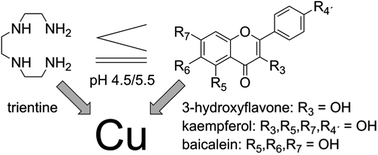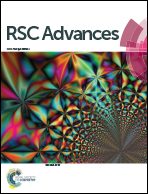In vitro evaluation of copper-chelating properties of flavonoids†
Abstract
Copper is an essential trace element involved in plenty of redox reactions in living systems, however, unbound copper ions cause damage to various biomolecules via excessive generation of reactive oxygen species. Flavonoids, ubiquitous plant secondary metabolites, possess complex effects on human health and chelation of transient metal ions is one of their proposed mechanisms of action. In this in vitro study, 26 flavonoids from various subclasses were screened for their interactions with both copper oxidation states at four (patho)physiologically relevant pH conditions (4.5, 5.5, 6.8 and 7.5) by two spectrophotometric approaches and compared with the clinically used copper chelator trientine. In a slightly competitive environment, the majority of flavonoids were able to chelate cupric ions, however, under more competitive conditions, only flavones and flavonols were able to chelate both cupric and cuprous ions. Apparently, the 2,3-double bond was essential for stable copper chelation. The most efficient copper chelation sites were the 3-hydroxy-4-keto group in flavonols and the 5,6,7-trihydroxyl group in flavones. On the other hand, the 3′,4′-dihydroxyl group was associated only with a weak activity. 3-Hydroxyflavone, kaempferol and partly baicalein were even more potent than trientine in the acidic environment, however, none of the tested flavonoids was able to surpass it at physiological pH or slightly acidic conditions. In conclusion, flavonoids possessing appropriate structural characteristics were efficient copper chelators and some of them were even more potent than trientine under acidic conditions.


 Please wait while we load your content...
Please wait while we load your content...